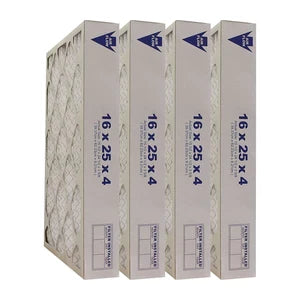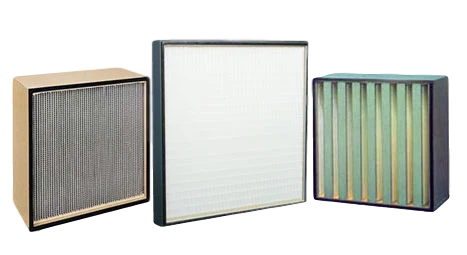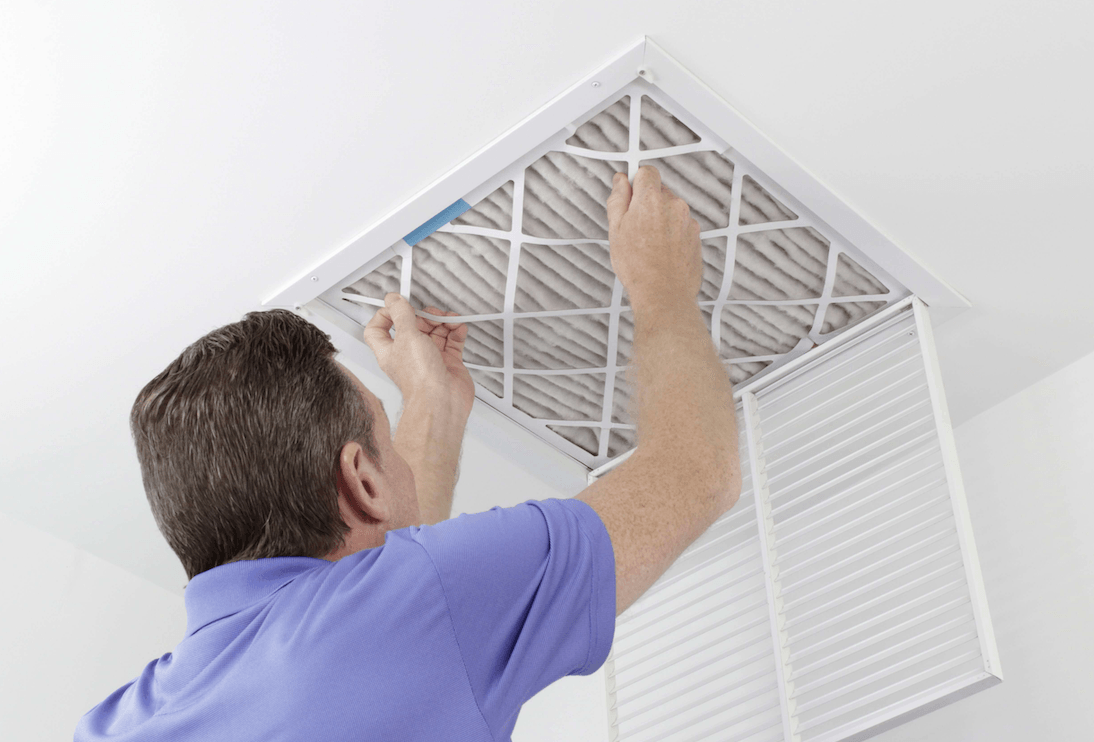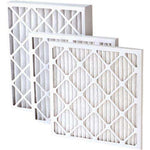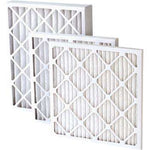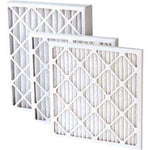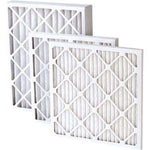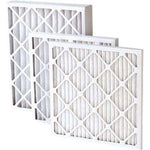You have no items in your shopping cart.
Choosing a replacement furnace filter might not sound like a difficult task, but when you look at the numerous options available, your decision may suddenly become surprisingly complex and confusing. The easiest choice is to get an exact replacement of what you already have. But is that costing you more than it should? Are you getting the most efficiency from your system? So maybe you’ve decided to look for an alternative. But which product? We’ve reached out to the experts who have their own testing lab facilities to evaluate a large range of products. The experts – in this case, a local HVAC specialist, Michael Hurns – made sure to cover every aspect of furnace filters, from construction to performance.
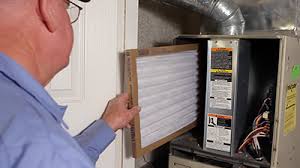
*Note: Most manufacturers suggest replacing filters every three months. If any members of the household have conditions that affect breathing, however, you should change them more often.
A furnace filter seems to be an insignificant component of the furnace or A/C system, but good airflow is really important. If your furnace filter is clean, it allows for efficient air flow. If it's really clogged and holding a lot of debris, it will force your hvac system to work harder. In turn, this will bring higher energy bills and reduced air quality.
Some suggest that a little dust is no bad thing, that it can actually improve filtration. That's not really an accurate reflection of what's going on, as expert Michael Hurns points out.
“Furnace filters that are less efficient actually become more efficient as the filter loads up with dust and debris. The filter media, over time, let’s smaller and smaller particles pass through. Meaning the filter starts trapping even finer dust. “This advantage is short-lived, though.” If left unchecked for too long, the furnace filter will become too clogged, and the airflow will become severely restricted.
The best solution is a proper maintenance schedule. It's a good idea to keep a log, check your filter regularly, and replace it as recommended by the manufacturer (or if you notice its performance starting to deteriorate).
It's false economy to try to extend the life of filters beyond their specifications. Any money you might save on the filters themselves is lost on higher energy bills. If anyone in the household has respiratory difficulties, you're also making things tougher on them.
How a furnace filter is made
Filters usually have an aluminum, steel, or plastic framework containing a filtering element made of fiberglass, polyester, cotton, or paper. They're designed to trap particles of dust and dirt that adversely affect the components and performance of your system and have a negative impact on household air quality.
The majority of filters are pleated, offering a large surface area without increasing the exterior dimensions.
Filters can be disposable or washable. Disposable filters are convenient, easy to change, and usually last several months. Washable filters can last years if looked after properly. But they must be cleaned regularly (usually every 30 days) and thoroughly. If not done correctly, there is a danger of spreading bacteria. If considering this option, you need to ask yourself the question of whether or not you are prepared to keep up with the maintenance?
Choosing the right furnace filter
There are two things to check when choosing a replacement furnace filter: size and filtration level.
Size
It's important to get the right size, as there's no room for maneuvering. Furnace filters either fit or they don't.
Sizing should be clear from your existing filter and will be given as the length x height x thickness – 16x25x1 furnace filter, for example. These measurements are in inches, but the inch marking is not normally shown.
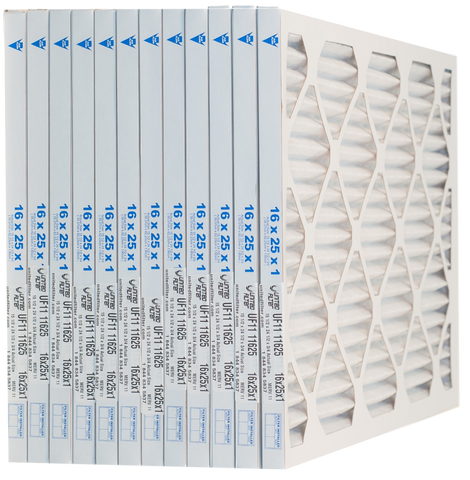
Most filters are one inch thick, but some are two inches, four inches and five inches in thickness. In theory, a thicker filter gives greater filtration – but they aren't interchangeable. If the existing furnace filter is 1 inch thick, a four inch filter will not fit without having to modify the opening to your hvac setup. Even if that were practical (which is unlikely), your system might only have sufficient airflow for a one-inch filter anyway. Putting a thicker version in could actually reduce effectiveness.
MERV Rating
The vast majority of disposable furnace filters are rated according to the MERV rating scale (minimum efficiency reporting value) created by the American Society of Heating, Refrigerating, and Air-Conditioning Engineers (ASHRAE). The higher the number, the finer the filter, so the more particles it traps.
Disposable filters offered for household use vary between MERV 6 and MERV 13. However, experts recommend MERV 8 as a minimum and MERV 11 for better filtration of airborne particles.
Commercial filters are available with much higher MERV ratings, but most household systems don't generate sufficient airflow, so they should not be used.
Washable filters are not covered by MERV ratings, and their specifications can seem confusing. Some claim to trap a certain percentage of airborne particles, but they don't tell you what size those particles are.
Our expert explains: “Manufacturer claims such as “removes 95 percent of dust” are meaningless without knowing the size/type of particles you are discussing. A very poor (airy) filter can trap 95% of larger particles but only 3% of very small particles. Filters that claim to remove, say, 99% of pollen or mold, are sometimes basing that on removing whole pollen or mold grains and do not factor in particle fragments (they break up into finer particles).”
Electrostatic furnace filters (Recommended!)
Many furnace filter manufacturers now use the terminology "electrostatic" in their product descriptions. An electrostatically charged filter is better than a standard pleated filter. They’re recommended for homes with allergy sufferers, smokers, or pets. The electrostatic charge is added during manufacturing. There is no requirement for a separate electrical supply. It's not something that needs to be re-charged.
Furnace Filter Prices
A good furnace filter isn't expensive. However, it is difficult to give accurate prices because of the enormous variety of materials and sizes and the competitive nature of the furnace filter market.
As a rough guide, disposable electrostatic furnace filters start at around $7 or $8 each for the typical 16x25x1 filter. The price rises to between $15 and $20 for larger thickness filters like 16x25x5. Additionally, you will pay a little more a furnace filter with a higher MERV rating.
Washable filters, not surprisingly, are considerably more expensive. Expect to spend anywhere from $30 to $50 apiece, depending on construction.
Tips from our expert, Michael Hurns.
Filter quality and value depend on the application, including the size and airflow of the HVAC system. For example, the higher the MERV filter value, the better the dust removal – if your system can push air through it.
Running the HVAC system on continuous fan is the best way to clean the air regardless of the type of filter you use.
Less-efficient filters get more efficient as they load, since the pores begin to fill, spaces between the media fibers get smaller, and they start trapping finer dust. Of course, this also means the filters are clogging and will soon obstruct airflow.
How often you need to change the filter will depend on how efficient it is, how much you run the fan on your HVAC unit, and how many dust sources you have inside.
The best filters tell you the percentage of particles removed by size at a given airflow.
HVAC systems and filters are like vacuum cleaners. They should move enough air to clean the environment without allowing the dust to blow back into your home.
Replacing you furnace filters regularly helps your system perform at its best. We also recommend regular maintenance visits from a properly qualified HVAC specialist.
As our expert tells us, “A great filter is the most efficient one your HVAC system can handle while still moving enough air to make a difference.”
Frequently Asked:
- What is a micron?
- A micron (or micrometer) is one millionth of a meter, or 0.000039 inch. To give you an idea of just how small that is, a human hair is about 70 microns thick.
- How often do I need to replace my furnace filter?
- It depends on a number of factors. A 16x25x1 MERV 8, 1” filter should be changed every 60 days. Thicker filters can last up to 4 months.
If you have pets or are a smoker, your filters will become clogged more quickly. If you have breathing difficulties, you'll probably want to change them more often because you'll be more susceptible to airborne particles.
Your furnace or HVAC manual should give you the information you need. You can also get information from filter suppliers. Follow the instructions carefully.
Choosing a replacement furnace filter might not sound like a difficult task, but when you look at the numerous options available, your decision may suddenly become surprisingly complex and confusing. The easiest choice is to get an exact replacement of what you already have. But is that costing you more than it should? Are you getting the most efficiency from your system? So maybe you’ve decided to look for an alternative. But which product? We’ve reached out to the experts who have their own testing lab facilities to evaluate a large range of products. The experts – in this case, a local HVAC specialist, Michael Hurns – made sure to cover every aspect of furnace filters, from construction to performance.

*Note: Most manufacturers suggest replacing filters every three months. If any members of the household have conditions that affect breathing, however, you should change them more often.
A furnace filter seems to be an insignificant component of the furnace or A/C system, but good airflow is really important. If your furnace filter is clean, it allows for efficient air flow. If it's really clogged and holding a lot of debris, it will force your hvac system to work harder. In turn, this will bring higher energy bills and reduced air quality.
Some suggest that a little dust is no bad thing, that it can actually improve filtration. That's not really an accurate reflection of what's going on, as expert Michael Hurns points out.
“Furnace filters that are less efficient actually become more efficient as the filter loads up with dust and debris. The filter media, over time, let’s smaller and smaller particles pass through. Meaning the filter starts trapping even finer dust. “This advantage is short-lived, though.” If left unchecked for too long, the furnace filter will become too clogged, and the airflow will become severely restricted.
The best solution is a proper maintenance schedule. It's a good idea to keep a log, check your filter regularly, and replace it as recommended by the manufacturer (or if you notice its performance starting to deteriorate).
It's false economy to try to extend the life of filters beyond their specifications. Any money you might save on the filters themselves is lost on higher energy bills. If anyone in the household has respiratory difficulties, you're also making things tougher on them.
How a furnace filter is made
Filters usually have an aluminum, steel, or plastic framework containing a filtering element made of fiberglass, polyester, cotton, or paper. They're designed to trap particles of dust and dirt that adversely affect the components and performance of your system and have a negative impact on household air quality.
The majority of filters are pleated, offering a large surface area without increasing the exterior dimensions.
Filters can be disposable or washable. Disposable filters are convenient, easy to change, and usually last several months. Washable filters can last years if looked after properly. But they must be cleaned regularly (usually every 30 days) and thoroughly. If not done correctly, there is a danger of spreading bacteria. If considering this option, you need to ask yourself the question of whether or not you are prepared to keep up with the maintenance?
Choosing the right furnace filter
There are two things to check when choosing a replacement furnace filter: size and filtration level.
Size
It's important to get the right size, as there's no room for maneuvering. Furnace filters either fit or they don't.
Sizing should be clear from your existing filter and will be given as the length x height x thickness – 16x25x1 furnace filter, for example. These measurements are in inches, but the inch marking is not normally shown.

Most filters are one inch thick, but some are two inches, four inches and five inches in thickness. In theory, a thicker filter gives greater filtration – but they aren't interchangeable. If the existing furnace filter is 1 inch thick, a four inch filter will not fit without having to modify the opening to your hvac setup. Even if that were practical (which is unlikely), your system might only have sufficient airflow for a one-inch filter anyway. Putting a thicker version in could actually reduce effectiveness.
MERV Rating
The vast majority of disposable furnace filters are rated according to the MERV rating scale (minimum efficiency reporting value) created by the American Society of Heating, Refrigerating, and Air-Conditioning Engineers (ASHRAE). The higher the number, the finer the filter, so the more particles it traps.
Disposable filters offered for household use vary between MERV 6 and MERV 13. However, experts recommend MERV 8 as a minimum and MERV 11 for better filtration of airborne particles.
Commercial filters are available with much higher MERV ratings, but most household systems don't generate sufficient airflow, so they should not be used.
Washable filters are not covered by MERV ratings, and their specifications can seem confusing. Some claim to trap a certain percentage of airborne particles, but they don't tell you what size those particles are.
Our expert explains: “Manufacturer claims such as “removes 95 percent of dust” are meaningless without knowing the size/type of particles you are discussing. A very poor (airy) filter can trap 95% of larger particles but only 3% of very small particles. Filters that claim to remove, say, 99% of pollen or mold, are sometimes basing that on removing whole pollen or mold grains and do not factor in particle fragments (they break up into finer particles).”
Electrostatic furnace filters (Recommended!)
Many furnace filter manufacturers now use the terminology "electrostatic" in their product descriptions. An electrostatically charged filter is better than a standard pleated filter. They’re recommended for homes with allergy sufferers, smokers, or pets. The electrostatic charge is added during manufacturing. There is no requirement for a separate electrical supply. It's not something that needs to be re-charged.
Furnace Filter Prices
A good furnace filter isn't expensive. However, it is difficult to give accurate prices because of the enormous variety of materials and sizes and the competitive nature of the furnace filter market.
As a rough guide, disposable electrostatic furnace filters start at around $7 or $8 each for the typical 16x25x1 filter. The price rises to between $15 and $20 for larger thickness filters like 16x25x5. Additionally, you will pay a little more a furnace filter with a higher MERV rating.
Washable filters, not surprisingly, are considerably more expensive. Expect to spend anywhere from $30 to $50 apiece, depending on construction.
Tips from our expert, Michael Hurns.
Filter quality and value depend on the application, including the size and airflow of the HVAC system. For example, the higher the MERV filter value, the better the dust removal – if your system can push air through it.
Running the HVAC system on continuous fan is the best way to clean the air regardless of the type of filter you use.
Less-efficient filters get more efficient as they load, since the pores begin to fill, spaces between the media fibers get smaller, and they start trapping finer dust. Of course, this also means the filters are clogging and will soon obstruct airflow.
How often you need to change the filter will depend on how efficient it is, how much you run the fan on your HVAC unit, and how many dust sources you have inside.
The best filters tell you the percentage of particles removed by size at a given airflow.
HVAC systems and filters are like vacuum cleaners. They should move enough air to clean the environment without allowing the dust to blow back into your home.
Replacing you furnace filters regularly helps your system perform at its best. We also recommend regular maintenance visits from a properly qualified HVAC specialist.
As our expert tells us, “A great filter is the most efficient one your HVAC system can handle while still moving enough air to make a difference.”
Frequently Asked:
- What is a micron?
- A micron (or micrometer) is one millionth of a meter, or 0.000039 inch. To give you an idea of just how small that is, a human hair is about 70 microns thick.
- How often do I need to replace my furnace filter?
- It depends on a number of factors. A 16x25x1 MERV 8, 1” filter should be changed every 60 days. Thicker filters can last up to 4 months.
If you have pets or are a smoker, your filters will become clogged more quickly. If you have breathing difficulties, you'll probably want to change them more often because you'll be more susceptible to airborne particles.
Your furnace or HVAC manual should give you the information you need. You can also get information from filter suppliers. Follow the instructions carefully.
